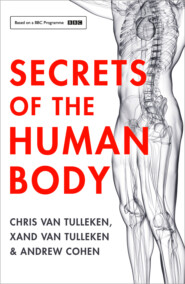По всем вопросам обращайтесь на: info@litportal.ru
(©) 2003-2024.
✖
Wonders of Life
Автор
Год написания книги
2019
Настройки чтения
Размер шрифта
Высота строк
Поля
O – but this simplicity is deceptive, because the geometry of the water molecules themselves means that their collective behaviour is tremendously subtle and complex. The diagram below shows a series of different molecules, each consisting of hydrogen atoms covalently bonded to different elements. The simplest is hydrogen fluoride, which forms a linear structure as there are only two atoms – one of fluorine and one of hydrogen. Fluorine bonds with only one hydrogen atom because it has only a single electron in its outer shell. Water has two electrons available for bonding, but it also has two pairs of electrons sitting inertly in its outer shell. Inert they may be, but they still have to ‘fit’ somewhere, and their presence means that water molecules are not linear. The hydrogen atoms sit on one side of the oxygen, at an angle of 104.45°.
This has a very important consequence. Electrons are negatively charged, and the nuclei of hydrogen, being single protons, are positively charged. Water’s angled geometry means that the region surrounding the hydrogen atoms has a slight positive charge, and the region away from the hydrogen atoms has a slight negative charge. This means that water is a ‘polar’ molecule – one side is slightly negatively charged, and the other is slightly positive, although the molecule itself remains electrically neutral. This is the reason for the unexpected behaviour of water in a classic school science experiment. Take a Perspex rod (one of those perplexing objects found in every science laboratory but nowhere else) and rub it against a fleece. This gives the rod an electric charge, in much the same way that you might get charged up by walking across a carpet and discharged uncomfortably by grabbing a door handle. If you move the rod next to water flowing out of a tap, the stream of water will bend because the positive and negative sides of the water molecules are either attracted to or repelled by the electric charge on the rod.
It is the polar nature of water molecules that gives this seemingly innocuous liquid an array of complex properties so vital for life on Earth. The molecules are not only attracted to or repelled by external electrically charged objects, they also attract each other, forming weak bonds known as hydrogen bonds. Water isn’t the only liquid to do this – hydrogen fluoride and ammonia also exhibit hydrogen bonding for the same reason – they have a negative and positive side to them because of their geometry and the distribution of the electrons around their component atoms.
HYDROGEN BONDS
Water bends towards a Perspex rod that has been rubbed against a fleece. The rod has an electric charge, caused by the rubbing, and the water bends because of its own polar nature.
One of the most immediate consequences of hydrogen bonding is a dramatic rise in the boiling point of these substances. Methane, which is a symmetric molecule because it has four hydrogen atoms surrounding its central carbon atom (see diagram), is not polar and does not exhibit hydrogen bonding. This means that methane molecules are only very weakly bonded together in the liquid state, and it doesn’t take much energy to split them apart from each other and turn liquid methane into a gas. This is why the boiling point of methane is a chilly -162°C. Ammonia, on the other hand, with only one hydrogen less than methane and a very similar molecular size and weight, exhibits hydrogen bonding because it is polar, and its boiling point is a fairly warm -33°C, a temperature regularly reached in cold areas on our planet. Hydrogen fluoride is also polar, because of fluorine’s voracious appetite for electrons, and it boils at room temperature. And water, of course, boils at 100°C at room temperature and standard atmospheric pressure, because of its strong hydrogen bonds. We can get an idea of the importance of hydrogen bonds by comparing water to hydrogen sulphide, a very similar molecule in terms of weight and size, but with an atom of sulphur replacing the oxygen atom at its heart. H
S does not exhibit hydrogen bonding, because the sulphur atom does not drag the electron cloud around it as effectively as oxygen. This is because it has an extra inner shell of electrons shielding the positive electric charge of its nucleus. As a result, H
S boils at -60°C. Without hydrogen bonding, therefore, there would be no liquid water on the balmy Earth – no oceans, no rivers and lakes, no raindrops and no life.
It is also water’s strong hydrogen bonds that explain the pond skater’s ability to walk on water. To understand why, it is necessary to think just a little about the nature of chemical bonds themselves. The reason a bond forms, at the most fundamental level, is because it is energetically favourable for it to do so. This means that a clump of water molecules loosely attached to each other by a network of hydrogen bonds is a lower energy configuration than a swarm of water molecules freely whizzing around ignoring each other.
The influence of water on biology is immense; indeed, perhaps we cannot truly understand biology until we understand water.
Think about what it means to boil water. You have to put energy into the water to boil it and produce steam; steam is gaseous water, which means that the molecules are whizzing around ignoring each other. When you heat water up, some of the energy goes into breaking the hydrogen bonds between the water molecules. If you have to put energy in to break the bonds, then it must mean that you get energy out by letting the hydrogen bonds re-form and allowing the steam to condense back into water again. This is why steam burns you easily – when it touches your skin and condenses into water, a large amount of energy is released and this hurts! Part of what you are feeling is the energy released as the network of hydrogen bonds re-forms, turning the steam back into liquid.
Because the hydrogen-bonded liquid state of water is a lower energy configuration than the non-hydrogen-bonded gaseous state, this has an interesting effect at the water’s surface. Hydrogen-bonding lowers the energy of a collection of water molecules, so every water molecule wants to hydrogen bond to others if it can. The molecules at the surface, however, don’t have as many molecules to bond with, as above them there is only air. This means that it is always energetically favourable for water to minimise its surface area; less surface means more hydrogen bonds.
When a pond skater puts its hairy, hydrophobic legs onto the water’s surface, it bends the surface and therefore increases the surface area. This increases the energy of the water, which pushes back, trying to flatten its surface and thereby reducing its energy. This force is known as surface tension, and it keeps the pond skater afloat. This is also, by the way, the reason why raindrops are spherical. A sphere is the shape that minimises the surface area of a water drop, and it is therefore the most energetically favourable shape for a collection of water molecules to assume.
Water’s high boiling point and surface tension are just the beginning, as far as biology is concerned. Water’s polar nature doesn’t only allow the formation of hydrogen bonds between water molecules, it also allows it to break up other weakly bonded molecular structures and disperse them. In other words, it is a superb solvent, able to dissolve salts and other nutrients which in turn allows them to be dispersed around the body and made available for chemical reactions to take place. It is also highly structured in its liquid phase. We now know that water behaves more like a gel than a liquid, with complex networks of hydrogen-bonded water molecules forming giant, fleeting structures. These structures, it is thought, play a vital role in the complex biological reactions within cells. In a sense, water acts like scaffolding around which biology can happen. It is known that the activity of proteins depends both on their chemical structure and their precise orientation and shape, and hydrogen bonding between water molecules and the protein molecules plays an important role in orientating these complex molecules so that they can carry out their biological functions correctly.
Water is a fascinating and unique substance – so much so that its influence on biology and its own internal structure, both created by hydrogen bonding, are still extremely active areas of research. This is why it is said that we won’t truly understand biology until we understand water. It is also the origin of the strong suspicion, shared by many biologists, that water is one of the essential ingredients for life, not only on Earth, but anywhere in the Universe.
INTO THE LIGHT (#ulink_aaf94e17-cc3f-5ba3-82d6-cd08b1d672e9)
Life on Earth is a dazzling continuum of organisms of dramatically varying sizes and complexities. There are some ingredients that all living things share: water, plus a handful of chemical elements vital for life, such as the constituents of DNA – hydrogen, oxygen, nitrogen, carbon and phosphorus. Other ingredients and conditions are necessary for the particular biosphere we find on Earth today. Without them, human beings would certainly not exist, but whether they are fundamental to the development of complex life is an open question.
Virtually every living thing on the planet today is ultimately powered by sunshine. Every mouthful of every meal has its origins in the Sun, from the fruit and vegetables created by plants that absorb sunlight directly, to the meat and fish that deliver their sunshine second- or third-hand as part of the complex food chain.
It appears today as if the Sun is a truly fundamental ingredient for life, a provider without which life couldn’t exist. Yet this intimate relationship with our nearest star is not a simple one. The Sun is a far from benevolent companion. Its radiant rain has a dark side that is as dangerous as it is nourishing, and early in the development of life on Earth it is likely that the Sun was a presence to be avoided rather than cherished. To understand how life transformed its relationship with light, we have to go back billions of years, to a time when life sheltered in the darkness. For many biologists, life on Earth didn’t begin in the light, but rather in the darkness of the deep oceans. The transformation of light from threat to food required one of life’s most extraordinary inventions: oxygenic photosynthesis. The evolution of this biological process ultimately resulted in the capture of carbon and the release of large amounts of oxygen into the atmosphere, which in turn played a key role in triggering the explosive evolution of life from the simple to the complex and conscious.
Without light, the process of oxygenic photosynthesis would not be possible. It was this biological process that resulted in the release of oxygen into the Earth’s atmosphere.
A TRAIN JOURNEY THROUGH TIME (#ulink_b1613a56-1a62-5b6e-bba7-99bb9640cd31)
The Chihuahua-Pacific railway has a vertical climb of 2,400 m (8,000 ft), and, as it climbs, the air thins and the colours of the world shift from warm reds to harsher blues.
As a rule, I don’t enjoy filming in jungles. Humidity and DEET combine, in my view, to create discomfort, and it is unfortunate that biodiversity implies lots of animals, some of which are best avoided. It was with some relief, therefore, that the crew and I left the verdant but challenging beauty of the Yucatan behind for the freshening altitudes of the north. With 37 bridges, 86 tunnels and a vertical climb of 2,400 m along 673 km of track, the Chihuahua-Pacific railway is one of the great train journeys of the world. The old train leaves the coastal town of Los Mochis at 6 am, shortly before the reddening sky delivers stripes of warming light into the wooden carriages through slatted blinds. As the train rattles away from the coastal plane, the landscape shifts from towns and villages to pine forests and mountains, and we head inwards and upwards towards Mexico’s mountainous interior and the Copper Canyon, a network of gorges to rival its more famous northerly neighbour, the Grand Canyon.
One shouldn’t need a reason to ride the Chihuahua-Pacific. It’s one of those things in life that’s worth doing, simply because it’s there. But, being a film crew, we have a reason; to observe the shifting nature of the Sun’s light as it arrives at the surface of the Earth. As early morning turns to afternoon and we rise into thinning air, the colours of the world shift from warm reds to harsher blues. These are real, physical changes picked up by our eyes as the quality of the sunlight itself changes owing to its varying path-length through the atmosphere.
Light is an electromagnetic wave; energy from the Sun sloshing back and forth between electric and magnetic fields and driving itself through the vacuum of space at just over 299,792 km per second. Being a wave, light has a wavelength, and it is different wavelengths of light that we see as different colours. Human eyes are sensitive to wavelengths between around 400 nanometres and 700 nanometres (a nanometre is a billionth of a metre). We see 450 nm light as blue, 500 nm light as green, and 600 nm light as orangey-red. Beyond the red, at longer wavelengths, lies the infrared. This is the radiation that we feel as heat, but cannot see. Some animals, such as the pit vipers, have evolved the ability to detect infrared light, but humans need night-vision goggles to do so.
At the short-wavelength end of the spectrum lies the ultraviolet. There are many animals that can see this light, from birds and bats to insects. Some flowers are intensely colourful in the ultraviolet part of the spectrum, yet their beauty remains hidden to us. The Sun is intensely active in the ultraviolet, but much of it is absorbed by the Earth’s atmosphere and never reaches the surface. This is a good thing, because short-wavelength UV is potentially extremely damaging to living things. To see why this is so, it is easier to think of light in another way. Light can also be viewed as a stream of particles called photons. The particulate nature of light was discovered at the turn of the twentieth century by Albert Einstein and others, and was one of the first steps in the development of quantum theory. The ‘quanta’ of light are known as photons, and the smaller the wavelength of the light, the higher the energy of the photons. High-energy UV photons are like little bullets, smashing into biological molecules with more than enough energy to break them apart. This is the reason why UV light can be dangerous. As the wavelength lengthens, however, the relationship of UV light with life becomes more ambiguous. Long-wavelength ultraviolet light, known as UVB, is beneficial to life (our bodies use it to produce vitamin D), but, just like the shorter wavelengths (UVC), it can also be damaging. UV light certainly poses a challenge to living things.
The red light of sunrise, seen from the Chihuahua-Pacific railway.
The train climbs through the Copper Canyon in Mexico’s interior.
As early morning turns to afternoon and we rise into thinning air, the colours of the world shift from warm reds to harsher blues.
As the hours pass on the Chihuahua-Pacific and we rise into the Mexican interior, two things happen: the Sun rises in the sky and the atmosphere becomes thinner. As the Earth’s atmosphere absorbs and scatters light of different wavelengths by different amounts, this changes the relative mixtures and intensities of wavelengths of light to which life is exposed. In particular, as the Sun climbs in the sky and the train climbs in altitude, the amount of potentially damaging UVB light rises dramatically. I measured the flux of UVB during the train journey with a small detector called a digital radiometer. In the early morning, with the Sun low in the sky at sea level, I measured a UVB flux of 22 microwatts per square centimetre. This is the power delivered to each square centimetre of a living thing by the ultraviolet light from the Sun. As the train climbed with the rising Sun, the UVB flux climbed to 260 microwatts per square centimetre, because the high-energy UVB photons had less atmosphere to pass through and were therefore less likely to be scattered or absorbed. My body’s response to this onslaught is to produce a pigment known as melanin. In simple terms, I get a suntan.
LIGHT SPECTRA
Coloured scanning electron micrograph of a section through human skin. The darker layer contains cells called melanocytes, which produce melanin.
The use of pigments such as melanin evolved very early in the history of life on Earth – forming a fundamental component of life. They are the way that life interacts with light and protects itself from harm.
Melanin is found in virtually all animals. In humans, this dark pigment is found in a type of cell under our skin called melanocytes. As high-energy ultraviolet photons rain down on our skin, they have the potential to damage the sensitive molecules that lie beneath. DNA is particularly susceptible to damage from UV, with potentially deadly consequences, and melanin is the first line of defence. The secret to its ability to shield cells from the damaging effects of high-energy photons lies in its molecular structure. Melanin is a complex molecule able to form polymers with varying structures depending on their location in the body. Its active heart, however, is a series of rings of carbon atoms bound together by a sea of mobile electrons. When a high-energy photon from the Sun hits one of the electrons, it doesn’t break the molecule apart. Instead, the energy is dissipated in around a pico-second, which is very fast indeed. In a million millionths of a second, the potentially threatening photon has been adsorbed and all its energy has been converted to heat. The melanin molecule survives intact to fight another day. Melanin is so efficient that over 99.9 per cent of the harmful UV radiation is adsorbed in this way, protecting cells from damage.
Melanin in its many forms is ubiquitous in nature; it is even found deep in the human brain, where its function is unknown. Even microorganisms such as bacteria and fungi employ melanin to protect themselves from UV radiation. This suggests that the use of pigments such as melanin evolved very early in the history of life on Earth – forming a fundamental component of life. They are the way that life interacts with light and protects itself from harm. While this would probably have been irrelevant for the very first life forms on Earth, which most likely lived deep in the oceans around hot-water vents, the dangers of UV light would have been one of the first challenges faced by life as first it rose to the ocean surface and then eventually colonised the land.
This image of the Sun, taken on 5–6 June 2012 by NASA’s Solar Dynamics Observatory, shows the transit of Venus, an event that will not happen again until 2117.
A CHILD STAR (#ulink_9eef6982-5824-5ea0-b8b3-12557bc9d1f0)
The Sun’s chromosphere is the source of ultraviolet radiation. It is thought that, in the first few billion years of its life, the Sun was seven times brighter in the ultraviolet.
Four billion years ago our planet was under siege. Bombarded by the rocky remnants of the Solar System’s foundation, our world was a tortured land of barren rock and dust-filled skies.
The early Earth was not a place that we would recognise as home – 4 billion years ago, our planet was under siege. Bombarded by the rocky remnants of the Solar System’s formation, our world was a tortured land of barren rock and dust-filled skies. The days were short, sweeping by in just five hours as the Earth spun frantically on its axis. Each morning this desolate landscape would have been met with the sight of a rising sun very different from the one we see today. Hanging in the sky was a sun in its infancy. If there had been human eyes to view it, it would have appeared only 70 per cent as bright as it is today, and Earth would have been in a kind of perpetual twilight. This raises an interesting question, because there is strong geological evidence that the temperatures on Earth were very similar to those today, and certainly permitted liquid water to exist on the surface. The reason for the relative stability of Earth’s climate as the Sun brightened is still a matter of research, although it is thought that a combination of higher concentrations of greenhouse gasses such as CO
in the atmosphere and, perhaps, less cloud cover resulting in less sunlight being reflected back out into space, kept surface temperatures high.
The relative lack of brightness, however, was deceptive. Beyond the visible and into the UV, the infant Sun was dazzling. This is because the Sun’s outer layers were much hotter than they are today, energised by the star’s higher spin rate giving rise to intense electromagnetic heating. Hotter surfaces radiate more of their energy in the high-energy, short-wavelength part of the spectrum – in other words, they are brighter in the ultraviolet.
It is thought that the young Sun was seven times brighter in the ultraviolet during the first few billion years of its life. The UV flux at the top of the Earth’s atmosphere would have been similar to that experienced by Mercury today, a planet around 100 million km closer to the Sun. The composition of the young Earth’s atmosphere is not well known, but it is unlikely that it was able to absorb such high levels of UV radiation. This suggests that it would have been necessary for life to deal with an intense UV onslaught, which may in turn have driven the evolution of pigments at a very early stage in its history.
The young Sun was seven times brighter during the first few billion years of its life. It would have been necessary for life to deal with an intense UV onslaught, which may in turn have driven the evolution of pigments at a very early stage in its history.
A coronal mass ejection blasts off the surface of the Sun in the direction of the Earth, and is deflected by Earth’s magnetic field.
The aurora borealis (northern lights) occurs when the solar wind – charged particles from the Sun – is drawn by the Earth’s magnetic field to the polar regions.
A UNIQUE AND COLOURFUL WORLD (#ulink_83396b5c-c076-59ab-9483-a1047bab4891)
On 18 March 2011, after a seven-year journey around our Solar System, NASA’s Messenger space probe became the first spacecraft to orbit the tortured inner planet of Mercury. Six days later it reactivated its dormant instrumentation, switching on its powerful cameras and returning the first photograph ever taken from Mercury’s orbit. This pioneering spacecraft has sent back thousands of images from the closest planet to the Sun, revealing in extraordinary high definition its complex surface, pitted with craters. But these images also reveal a monochrome world; there is little colour to decorate its dusty, damaged surface.
On its journey to Mercury, the Messenger spacecraft also flew by another of the inner planets – Venus. Again, despite all the acuity of modern technology, this is a planet painted with a limited pallet. A yellow fug shrouds another monochrome planet; a surface with texture but little colour.
Rocks on Mars (left, taken by the Curiosity Rover), compared with rocks on Earth (right). Both images exhibit rounded gravel fragments, suggesting that Mars, like the Earth, once had surface water.










